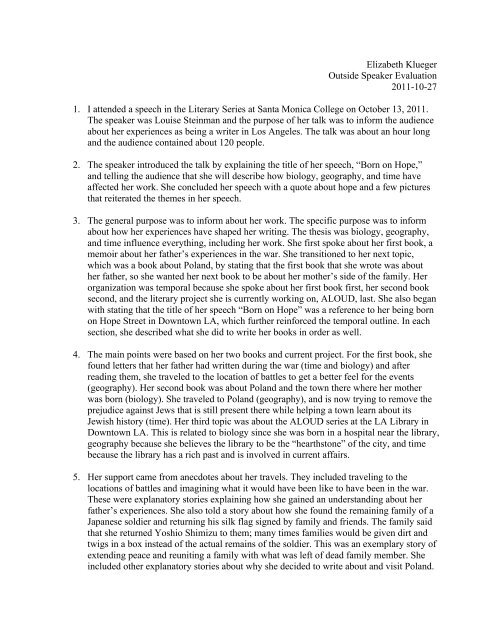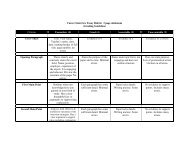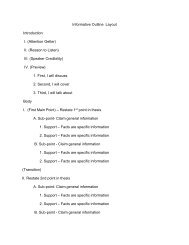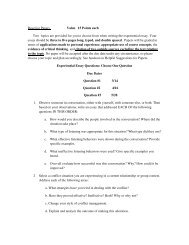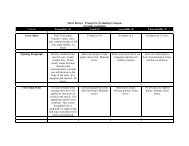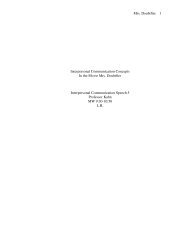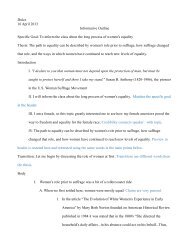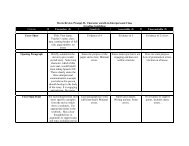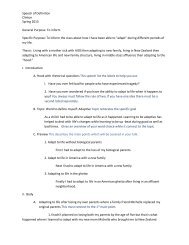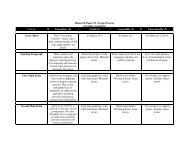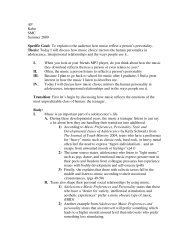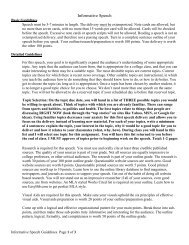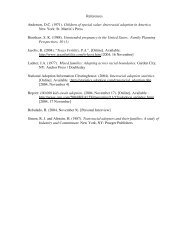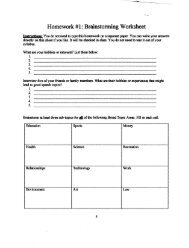Outside Speaker evaluation - Speechsuccess.net
Outside Speaker evaluation - Speechsuccess.net
Outside Speaker evaluation - Speechsuccess.net
Create successful ePaper yourself
Turn your PDF publications into a flip-book with our unique Google optimized e-Paper software.
Elizabeth Klueger<br />
<strong>Outside</strong> <strong>Speaker</strong> Evaluation<br />
2011-10-27<br />
1. I attended a speech in the Literary Series at Santa Monica College on October 13, 2011.<br />
The speaker was Louise Steinman and the purpose of her talk was to inform the audience<br />
about her experiences as being a writer in Los Angeles. The talk was about an hour long<br />
and the audience contained about 120 people.<br />
2. The speaker introduced the talk by explaining the title of her speech, “Born on Hope,”<br />
and telling the audience that she will describe how biology, geography, and time have<br />
affected her work. She concluded her speech with a quote about hope and a few pictures<br />
that reiterated the themes in her speech.<br />
3. The general purpose was to inform about her work. The specific purpose was to inform<br />
about how her experiences have shaped her writing. The thesis was biology, geography,<br />
and time influence everything, including her work. She first spoke about her first book, a<br />
memoir about her father’s experiences in the war. She transitioned to her next topic,<br />
which was a book about Poland, by stating that the first book that she wrote was about<br />
her father, so she wanted her next book to be about her mother’s side of the family. Her<br />
organization was temporal because she spoke about her first book first, her second book<br />
second, and the literary project she is currently working on, ALOUD, last. She also began<br />
with stating that the title of her speech “Born on Hope” was a reference to her being born<br />
on Hope Street in Downtown LA, which further reinforced the temporal outline. In each<br />
section, she described what she did to write her books in order as well.<br />
4. The main points were based on her two books and current project. For the first book, she<br />
found letters that her father had written during the war (time and biology) and after<br />
reading them, she traveled to the location of battles to get a better feel for the events<br />
(geography). Her second book was about Poland and the town there where her mother<br />
was born (biology). She traveled to Poland (geography), and is now trying to remove the<br />
prejudice against Jews that is still present there while helping a town learn about its<br />
Jewish history (time). Her third topic was about the ALOUD series at the LA Library in<br />
Downtown LA. This is related to biology since she was born in a hospital near the library,<br />
geography because she believes the library to be the “hearthstone” of the city, and time<br />
because the library has a rich past and is involved in current affairs.<br />
5. Her support came from anecdotes about her travels. They included traveling to the<br />
locations of battles and imagining what it would have been like to have been in the war.<br />
These were explanatory stories explaining how she gained an understanding about her<br />
father’s experiences. She also told a story about how she found the remaining family of a<br />
Japanese soldier and returning his silk flag signed by family and friends. The family said<br />
that she returned Yoshio Shimizu to them; many times families would be given dirt and<br />
twigs in a box instead of the actual remains of the soldier. This was an exemplary story of<br />
extending peace and reuniting a family with what was left of dead family member. She<br />
included other explanatory stories about why she decided to write about and visit Poland.
Some of the statistics she gave were related to the war and the history of town in Poland.<br />
One statistic was that the town was half Jewish and half Catholic, which she mentioned to<br />
support her claim that the town had a Jewish history, and that the prejudice that is still<br />
present today is unfair.<br />
6. She had a PowerPoint that consisted of pictures that were relevant to what she was<br />
speaking about. They pictures were of family, locations she visited, and items she spoke<br />
about in her speech. Her pictures were effective because they helped remind the audience<br />
what she was focusing on when she was talking and gave the audience an idea of what<br />
people and places were like. She talked about her pictures as soon as she changed to a<br />
new picture so that the audience wouldn’t be as distracted by the picture while she was<br />
talking, which I thought was effective.<br />
7. (at end)<br />
8. Her changes in speaking tone were appropriate to her speech. Some parts were emotional<br />
or moving, and it was evident that the experiences she talked about were meaningful to<br />
her. She did not talk too quickly and seemed at ease with talking to her audience.<br />
9. The speaker had good eye contact and appropriate movement. She could not walk across<br />
the room because of the screen on which her pictures were projected, so her lack of<br />
excessive movement was appropriate. She gestured to important details in her pictures<br />
and made sure to look at the audience, not the pictures.<br />
10. I would like to be able to apply the usage of appropriate visual aids as well as her<br />
organization. At the end of the speech, she stated a quote about hope from a speaker in<br />
the ALOUD series, which tied back to her title, “Born on Hope,” which was a reference<br />
to her birth at a hospital on Hope Street. She also began and ended her speech talking<br />
about Los Angeles. Returning to content from the beginning of the speech made the<br />
speech well organized with a solid conclusion. Her use of narratives as support worked<br />
well in her speech and were also very interesting.<br />
Outline<br />
Specific Goal: To inform about how my experiences have affected my writing.<br />
Thesis: Everything, including my work has been a product of biology, geography, and time.<br />
Introduction:<br />
I. So what does “born on hope,” the title of my talk, mean?<br />
II. I was born on Hope St. in downtown LA, not far from the library.<br />
III. The library is the hearth of the city.<br />
IV. Everything, including my work has been a product of biology, geography, and time.
Body:<br />
I. My first book is about my father’s experience in the war, which I determined from his<br />
letters.<br />
A. We were not allowed to talk about the war in my house, so the letters that I found<br />
were my opportunity to learn about the war from my father’s perspective.<br />
B. I traveled to locations of battles to getting a better feeling of the events that took<br />
place there.<br />
C. I returned what might have been the only remains of Yoshio Shimizu, a silk flag,<br />
to his family, reuniting them after many years.<br />
II. I wanted to write my next book on something related to my mother’s side of the<br />
family.<br />
A. Poland was considered a dark place for my mother, so I knew little about her<br />
family that had remained in Poland.<br />
B. I reluctantly took the opportunity to visit Poland when asked by my rabbi to go as<br />
an observer, but this visit made me realize that I had “inherited” a prejudice<br />
against Jews.<br />
C. After learning about the history of my mother’s home town, I am trying to negate<br />
a longstanding prejudice in Poland against Jewish people by helping them learn<br />
more about their Jewish history.<br />
III. I am now working on the ALOUD series of the Central Library in downtown LA.<br />
A. Because I grew up in downtown LA, the library has been a large presence in my<br />
life.<br />
B. The ALOUD series enriches the lives of many by bringing various speakers to<br />
interact with the audience.<br />
C. Here are some examples of past memorable speakers: Leymah Roberta Gbowee,<br />
who spoke the day before she received the Nobel Peace Prize; Susan Stamberg,<br />
who can be heard on NPR; and Charlie Beck, the Chief of the Los Angeles Fire<br />
Department.<br />
Conclusion<br />
I. This is a statue that I see every day at the library, which has varied pictures, which<br />
reminds me of the various influences in my work.<br />
II. One of the speakers of the ALOUD series said this about hope….


